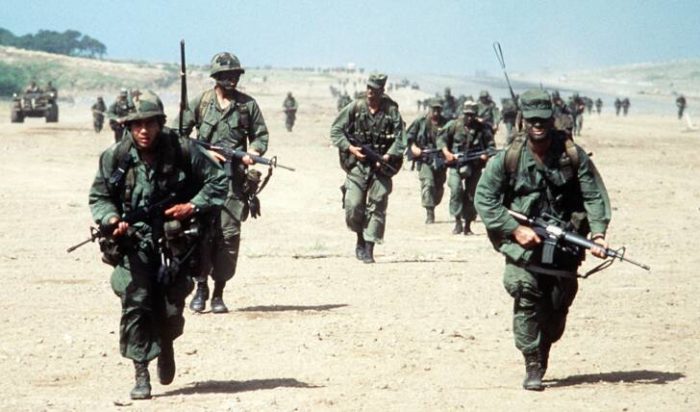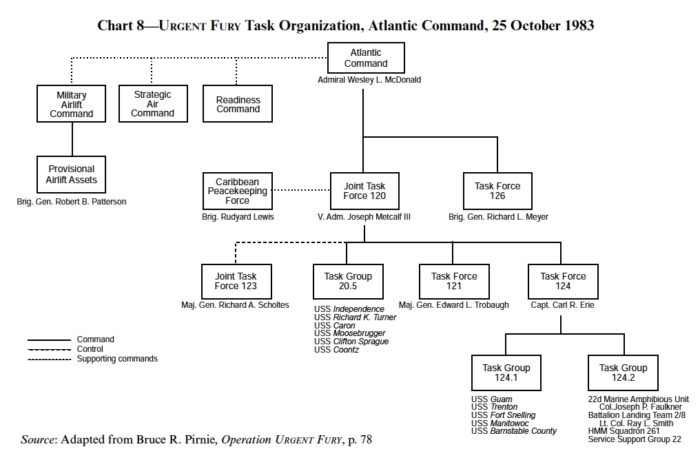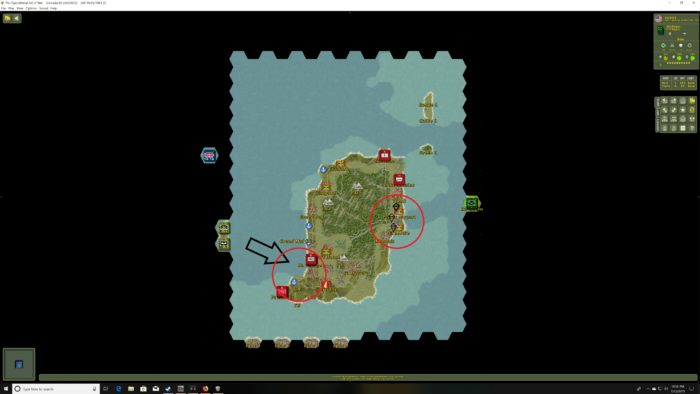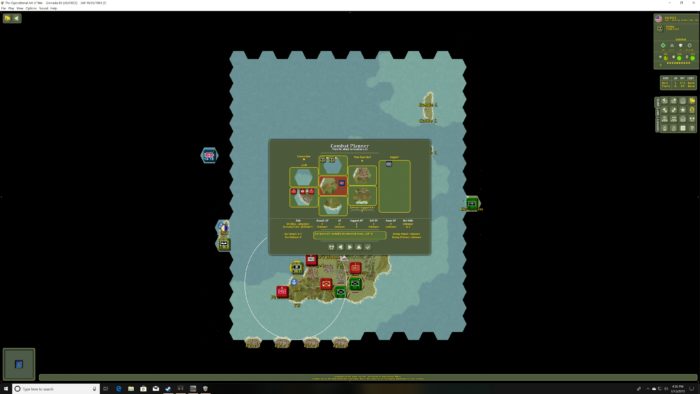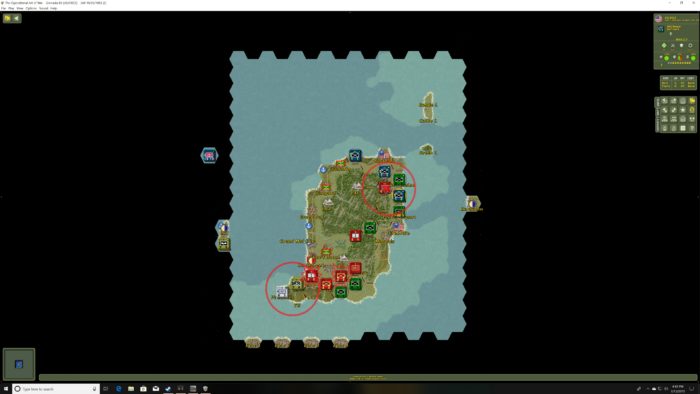Operation Urgent Fury – Grogheads Invades Grenada!
In October 1983, General Hudson Austin, the Commander-in-Chief of the armed forces of Grenada, launched a coup against the Marxist People’s Revolutionary Government (“PRG”) and its leader, Prime Minister Maurice Bishop. A week later, Bishop and his cabinet members were executed, the civilian government was disbanded and all of Grenada was placed on a 24-hour shoot-on-sight lock-down with approximately 1,000 Americans trapped on the small 120 square mile island nation. Still reeling from the recent hostage situation in Iran, and with reports of a rapidly deteriorating situation, the government of the United States decided to take decisive action planning in mere days a multi-pronged invasion involving elite units from across the full spectrum of the U.S. military.
The Operational Art of War IV, developed by TrickeySoft LLC and published by Slitherine Ltd. ships with a 12-turn scenario covering the late October 1983 invasion. Hopefully having learned from the blunders made by their historical counterparts, a crack team from Grogheads takes command of JSOC and Task Force 120 to see if it can accomplish the mission with greater precision and efficiency against the People’s Revolutionary Army bolstered by veteran Cubans. Check your parachutes, lock and load your weapons and get ready to jump in 3…2…1…
By: Craig H. Handler
On October 19, 1983, President Ronald Reagan authorized Operation Urgent Fury. The objective was three-fold: (i) evacuate U.S. citizens (mostly medical students attending St. George’s University); (ii) disarm hostile military forces; and (iii) restore orderly and lawful government to Grenada. To accomplish the mission, the U.S. Joint Chiefs created Joint Task Force (“JTF”) 120 under the operational command of Vice Admiral Joseph Metcalf III. His Army advisor was Major General Norman Schwartzkopf. JTF 120 was composed of the 22nd Marine Amphibious Unit, the 82nd Airborne Division and units from Joint Special Operations Command (“JSOC”), primarily Navy SEALs, Ranger Battalions, Delta Force commandos and teams of Air Force Combat Controllers.
The invasion was scheduled to kick-off at 0500 on October 25, 1983. This gave the command staff less than three (3) days to plan the entire operation. At the time of the emergency, very little was known about the small island nation, or its armed forces. In fact, over at Fort Bragg where the 82nd Airborne Division was preparing to depart, no maps of Grenada could be found, so they were purchased locally and literally handed to troops as they boarded their transports. In addition, officers read through copies of The Economist in order to obtain current information on Grenada.
According to available intelligence, the People’s Revolutionary Army (“PRA”) comprised of approximately 1,300 men, plus an unorganized reserve numbering somewhere between 2,000 and 4,000 men who were mostly communist party thugs. Cuba supplied the island with military advisors and a cadre of troops, who prior to D-Day, were believed to number 650 men. After the invasion, it was discovered that the Cuban troops on the island were commanded by Col. Pedro Tortolo and that his men were all veterans of operations on the African continent. Of course, all OPFOR were equipped with Soviet weapons, including small arms, light mortars, RPGs, and 90mm recoilless rifles. The PRA operated a handful of BTR-60 amphibious APCs, a few BRDM-2 scout cars and some ZSU-23-2 towed 23mm anti-aircraft guns. Although this was undoubtedly a light force overall, it still represented a threat to lightly armed infantry and the ZSUs, as well as the APCs armed with 14.5mm machine guns could be deadly to helicopters, or even large, slowly moving transport aircraft.
Historically, the first U.S. forces to deploy into the AO were a team of 12 Navy SEALs and four Air Force combat controllers, all divided into two eight-man teams. Late in the night of October 23rd, they parachuted into the waters off of Point Salines located on the extreme southern tip of the island. The two teams were tasked with gathering intelligence on the main runway located at Salines and to assess its defenses. They also had orders to place beacons that would be used by the transports dropping the paratroopers. The Salines airport was constructed by the Cubans in order to service large Soviet transports and heavy combat aircraft. As such, it was a key early objective in the battle since it would be used by the U.S. forces to deliver the main conventional invasion force.
The initial jump of the SEALs did not go well. Deployed from C-130s at just over 600 feet, four of the SEALs became tangled in their chute lines and drowned (they had not been trained to jump into water in the dark of night). The remaining operators lost one of their Zodiacs and encountered engine trouble with the other. Despite making two separate attempts over the course of October 23-24, they would not succeed in placing the beacons for the transport aircraft. The other airport on the island was located in the north at Pearls. On October 24th, another SEAL team landed and this time, successfully reconnoitered the area and beach. They radioed back to command that the beach was not suitable for an amphibious landing, advising that the invasion force tasked with taking the Pearls airport would have to be brought in by helicopter.
Our scenario begins in the early morning hours of October 25th. The briefing tells us that allied forces are composed of American troops and a small 358 man contingent of police and soldiers, mainly hailing from Jamaica and Barbados, from the Organization of Eastern Caribbean States (“OECS”). Defending the island, as previously noted, are Grenadine soldiers of the PRA with their Cuban contingent. There is a Battalion/Company unit scale and formations are on the Division/Brigade scale. Intelligence on enemy readiness and disposition is low, starting at just over 10%. The scenario lasts twelve turns of 6-hours each, or AM 10/25/83 through PM 10/28/83 and there will be several possible theater options that may have a significant impact on victory points (“VPs”).
Initial allied forces available on turn 1 consist of the 1st and 2nd battalions, 75th Infantry Regiment (“1/75” and “2/75”), two SEAL teams, a force from Delta and several companies from Second Battalion, 8th Marines (“2/8”). Supporting the invasion force is a squadron of A-7s flying off of CVA-62 USS Independence, AH-1S Cobras operating from LPH-9 USS Guam and an AC-130 Spectre Gunship, lending heavy fire support and a healthy dose of moral support too. Historically, the Rangers and SF teams were tasked with seizing Point Salines and its airfield, as well as rescuing American medical students at St. George’s University and freeing the island’s Governor-General Sir Paul Scoon, presently under house arrest in his mansion. Meanwhile, the Marines of 2/8 would come ashore in the north in order to take the airstrip at Pearls.
For some reason, I reversed the targets by planning on having the Marines hit Salines in the south, while the Rangers and SF teams would land at Pearls. I believe I most likely divided my forces in this manner based upon how they appeared and were pre-deployed on the scenario map.
As you can see, the scenario designer has the Marines of 2/8 aboard USS Guam off the western shore of Grenada, while the Rangers and SF teams are deploying from Barbados in the east. In any event, my plan is to use the Marines to hit the beaches outside of St. George’s proper and cut south to secure Point Salines and its airport and north to quickly rescue the medical students at the main St. George’s University campus, as well as another campus located at Grand Anse. As the Marines are storming ashore by sea, the Rangers from 1/75 and 2/75 will be dropping on Pearls in order to take the airstrip and then to move on Grenville and Tivoli. The Rangers will be supported by some SEALs and the D-boys from 1st Special Forces Operational Detachment-Delta (“SFOD-D”). Yes, just typing that gets me excited, but I digress. Anyway, I have eyes on a PRA anti-aircraft unit lurking in the area around Pearls. As some of these elite units will be assaulting from helicopters, disrupting or destroying the AA unit is of paramount priority on my to-do list.
My northern assault force lands successfully, quickly overtaking the PRA units defending the Pearls airstrip and otherwise meeting very light resistence. The Rangers attack and disrupt the AA unit, but not before it succeeds in damaging our orbiting AC-130 Spectre gunship forcing it to abort its mission and head for home, and consequently, miss out on the rest of the battle. The early loss of this asset was a significant set back and disappointment, but the show must go on. The SEALs and Delta teams come into contact with irregular PRA troops, which now appear to be generously scattered about the mountainous terrain located in the central and northern parts of the island. The irregular troops are no match for our elite units and they quickly fall back inland after a brief, but sharp skirmish.
The next turn has the Marines of E/2/8 and F/2/8 approaching the shore at St. George’s. More Rangers have landed in the south near Calivigny in order to hit the defenders of Point Salines from both sides and assist in securing the runway. This turned out to be a smart strategy since the bulk of the defending PRA and Cuban forces were positioned here. The Rangers quickly come into contact with the PRA’s mechanized units and Cuban security forces. In addition, the Marines and their supporting Cobras spot engineer and both PRA and Cuban command HQ units at or near the airport. In the north, SEAL Team 6 and Delta Force reposition to encircle the AA unit. VP objectives along the northwestern coast fall rapidly and without much fuss.
Its time for the Marines to earn their keep. We will use the combat planner that comes with TOAW IV to maximize the coordination of our attacking force. The Marines will be supported by Independence and its complement of A-7s, and a flight of Cobras will strafe the defenders too. Still, after all our assets are selected, intel states that our losses are expected to be heavy.
The Marines arrive and charge straight into combat encountering a mixed force of irregulars, engineers, one command group and some heavier ordnance like 75mm recoilless rifles, 82mm mortars and one ZSU-23. There are also two tracked earth movers that historically were commandeered by the attacking Americans and used to provide defensive cover while advancing on the enemy. Improvise Adapt Overcome! Our Marines do sustain some losses in the initial assault, but they are nowhere near as severe as originally anticipated.
It is now turn 3 and the Marines have regrouped having taken part of St. George’s, as well as the airport at Point Salines. Additionally, the civilian medical students have been safely rescued from the medical school and have been escorted to the airport. As soon as practical, they will board helicopters and be airlifted to the USS Guam. Their safe rescue has earned us significant VPs and has pushed us to an early substantial victory.
However, it is far too early to celebrate. The fight is not yet over and events will occur that erode our, thus far, very high level of accomplishment. At the end of turn 4, our men fail to locate Governor Scoon and he is executed together with his family. This is a drastic departure from what actually happened in the early invasion where Governor Scoon was freed and then protected by a team of 22 SEALs who fast-roped onto the roof of the mansion. The SEALs called in air support to suppress some of the BTR-60s that were laying siege to the compound, but the attack resulted in the loss of two Cobras after they were shot down by AA units positioned at nearby Forts Frederick and Rupert. When the Cobras failed to impact the course of the battle, the SEALs called for AC-130 support, allegedly using a commercial payphone and credit card to reach Fort Bragg to make the request. The Spectre attack was more successful, destroying one of the armored vehicles. Unfortunately, the SEALs could still not break out and ended up in a stand-off with PRA troops who also did not assault the mansion fearing that the position was held by larger numbers armed with heavier weapons. For the time being, the SEALs would hold fast with Scoon. After the loss of the two Cobras, Adm. Metcalf ordered a heavy airstrike from the Independence based A-7s on Forts Frederick and Rupert. The A-7s succeeded in destroying many of the heavier AA weapons, but tragically, also hit Fort Matthew, which although previously used by the PRA, had been converted to a mental hospital. In total eighteen patients and staff were killed by the errant A-7 raid.
Turing back to our game, the media is demanding access to the island and our troops, and the Soviets begin threatening to intervene. These events, including the murder of Scoon, strip us of valuable VPs and reduce our substantial victory to just a marginal one. Nevertheless, there is still much fighting to be done as the heaviest enemy formations remain intact.
Between turn 5 and 6 the grateful medical students are flown to the USS Guam and taken out of harms way. Having used our theater option to grant the media access to non-combat areas, journalists are there to see the medical students off and to greet them when they arrive on the Guam. The reports and photographs of their rescue boost morale, as well as our VPs. There is still very heavy fighting in the northern outskirts of St. George’s and near the Governor’s mansion as the heaviest enemy forces withdraw in good order fighting along the way. Our mixed force of Marines and Rangers is now in contact with irregular troops, engineers, military police squads, heavy anti-tank and support troops and some of the BTR-60s. Meanwhile, our firepower has been substantially increased by the arrival of G/2/8 and five (5) Marine M-60A1 tanks from LST-1180 USS Manitowoc and LSD-30 USS Fort Snelling, respectively, as well as the 2nd Battalion, 325th Airborne Infantry Regiment (“2/325”), which had been on standby at Pope Airforce Base and members of 1st Battalion, 505th Airborne Infantry (“1/505”).
By turns 9 and 10, most of the remaining PRA and Cuban forces have been pushed well north of St. George’s and have been surrounded. They are being pressured from Marines in the south and north and the Rangers moving in from Pearls to the west. The SEALs and Delta teams have been withdrawn and are no longer in the fight on the island. The enemy holdouts are also being bombed and strafed by the A-7s, Cobra helicopters and a flight of recently arrived Hughes 500MD Defender light attack choppers. By this point in the battle, the fight has been knocked out of the remaining PRA and Cuban units and many of them, despite being told to hold out to the last man for “the glory of the Revolution”, have begun shedding their uniforms and trying to blend into the civilian populace.
The surrounded enemy forces refuse to surrender though in turn 11, despite taking grievous losses. Perhaps due to their lingering presence on the battlefield, the appearance of enemy guerillas is triggered in the central mountains, causing some of our forces to reorient and attack to the southwest. The guerillas too are outmatched and outgunned. They will not survive the turn.
It is now turn 12, the final turn of the scenario, and all organized enemy resistance has ceased. The guerillas are surrounded and will be annihilated, doing little in terms of strategic significance, but by proxy of their mere appearance, we have lost VPs. Despite our overall level of success, my delay in granting full media access to combat areas, as well as Soviet threats of intervention have further deteriorated our once notable victory by subtracting further VPs.
Finally, by the end of turn 12 all enemy units on Grenada have been destroyed, or have surrendered. The official scenario result is labeled as a “draw”, or a “historical outcome”. It is hard to view this as accurately conveying the results of the battle since U.S. forces accomplished the majority of their strategic objectives early on in the scenario. Furthermore, losses were relatively light, while the entire enemy force was destroyed and all VP objectives on the map were captured. Historically, U.S. forces suffered 19 KIA and 116 wounded. Cuban losses totaled 25 KIA, 59 WIA and about 640 captured. PRA forces suffered 45 dead and 358 wounded. The civilian toll was 24 dead, most of which were killed in the mistaken bombing of Fort Matthew. Overall, the operation is viewed as a total and rapid success. However, the U.S. made many notable mistakes across its chain of command. After the invasion, the Department of Defense reviewed the performance of the units involved and determined that significant changes to the way the services communicate and coordinate were needed. The changes were implemented by the Goldwater-Nichols Department of Defense Reorganization Act of 1986, which increased the powers of the Chairmen of Joint Chiefs of Staff and created a truly unified joint U.S. military, including the formation of the U.S. Special Operations Command in 1987. Following the invasion, the Grenadians held free democratic elections and to this day, October 25th is still celebrated as a national holiday and day of thanksgiving.
This article is written in honor of all those lost in Operation Urgent Fury.
For further reading, see:
https://airspacehistorian.wordpress.com/category/falklands-war/
https://history.army.mil/html/books/grenada/urgent_fury.pdf
Chat about it below, or in our forums, or hit our FaceBook page >>


